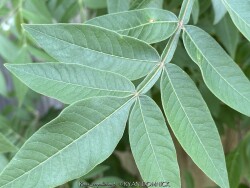
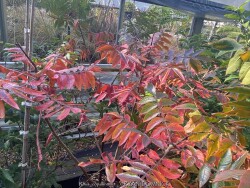
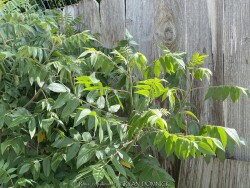

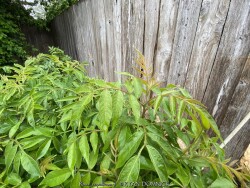
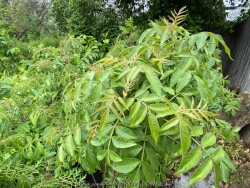
Plant Min Zone: 3a
Plant Max Zone: 9a
Sunlight: All Day Full Sun, Full Sun
Water / Rainfall: Low, Average
Soil Quality: Poor, Average
Bloom Season: Early Summer
Flower Color: Yellow
Berry / Fruit Color: Maroon, Orangish Red
Spring Foliage Color: Dark Green
Summer Foliage Color: Dark Green
Fall Foliage Color: Red
Evergreen Foliage: No
Winter Interest: No
Scented Flowers: No
Drought Tolerance: High
Wet-Feet Tolerance: Low
Humidity Tolerance: Medium
Wind Tolerance: High
Poor Soil Tolerance: Rocky Soils, Sandy Soils, Shallow Soils, Clay Soils, Alkaline Soils (high PH)
Height: 5' - 7'
Width: 5' - 7'
Growth Rate: Extremely Fast
Service Life: Long: 5-10 years
Maintenance Need: High
Spreading Potential: High
Yearly Trimming Tips: Trim Shrub to Desired Size After Bloom in Late Spring or Summer: Blooms on Old Wood.
Plant Grouping Size: Medium Grouping of 5-10, Mass Planting of 10 or more
Best Side of House: South Exposure, West Exposure, East Exposure
Extreme Planting Locations: Survives Under Roof Overhang, Survives Severe Drought, Tolerates Extreme Heat, Top of Retaining Wall Locations, Resistant to Rabbits
Ornamental Features: Multiple Seasons of Interest, Long Lasting Fall Color
Special Landscape Uses: Hedge Row, Erosion Control, Naturalizing
Possible Pest Problems: Root Rot Disease
Plant Limitations: Sometimes Mistaken as Weed, May Be Too Invasive for Garden Use
Shippable in 2026: YES
***Shrub descriptions available with future update!***>>>>>Flameleaf / Winged Sumac (Rhus copallinum) features bright green leaves that turn brilliant red in the fall. Light yellow flowers and occasional red berries are also ornamental features.>>>>>>It will thrive in full sun in medium to bone dry soils. In the landscape, it is commonly used as large mass planting on hills and berms. Because of its tolerance for adverse conditions including poor soil and rock, it is often one of the last resort plants that will survive in certain areas. This plant also does well in hot dry parking lot islands (hell-strips) or along busy roads. Plants adapt well to hot south or west sides of the house enduring temperatures of over 100 degrees F with no foliage burn. Another great spot is planting on top of a retaining wall allowing it to cascade down. We do not recommend planting in small areas or in spaces that it will overrun neighboring plants. Avoid potentially poorly drained areas or root-rot will occur.